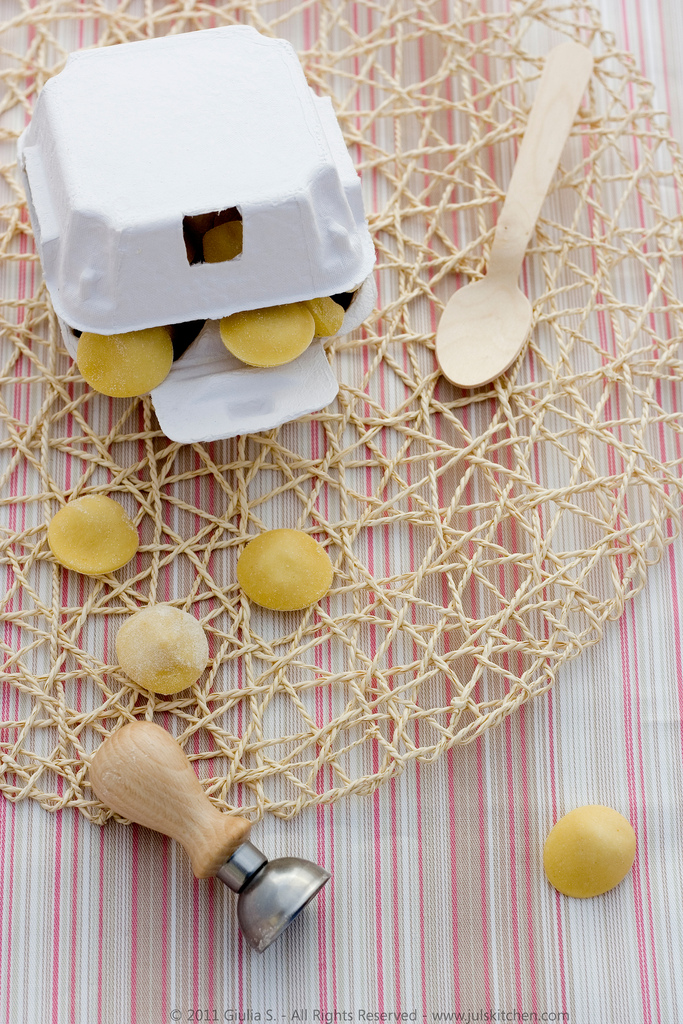Tuscan fried chicken. A recipe from a cooking class
Last week, battering and frying two kilos of free-range chicken during a class, surrounded by the carefree chitchat of a group of women cooking together, my mind started wandering.
If there’s something I’ve been missing in the past two years without cooking classes, that’s the conviviality that permeates every minute of the time spent together.
From the very first moment when I open the studio doors and exclaim – This is your kitchen for today, make yourself at home! – to when we say goodbye at the gate with an overexcited Noa, drunk for all the cuddles and ear scratches she received during the day, I experience a blissful sensation of conviviality, of familiarity even, with strangers I just met, that at the end of the class feel a bit like family.
Do you know when you meet someone and immediately bond over a shared meal, as the food brings out family memories, silly episodes, past adventures, and quirky habits that all of a sudden seem so normal? Well, this is now happening at least once a week. It leaves me invariably delighted, exhausted, and replete.

Having many industrious hands eager to learn is the best chance to tackle recipes that require time and a little dedication.
That’s when double shelling fava beans for a green spring salad turns into an occasion to chat, and when hand pulling chubby pici and coiling them around your hands before placing the nests onto a well-floured wooden board becomes a family competition. Who’s the best pici maker? I always bet on kids.
There are recipes that I had made over and over during cooking classes and that I neglected for more than two years: had I had too much of them? Or was that an instinctive response to a radical change of life? What I reckon is that my itch for long crowded tables and for carefully crafted menus was second just to my desire to finally hug my sister and my extended family.
Now all these recipes are coming back, along with the longed-for hugs.
It’s finally time to feast again on fried zucchini flowers, pici all’aglione, chocolate ricotta crumble cake, and slabs of freshly baked focaccia doused in extra virgin olive oil.
It was also time to refresh my menus, inspired by all the research I had done in the past months for our upcoming cookbook. As we substituted all the disposable napkins with durable cotton napkins and opted for homemade sourdough bread as a must-have in each class, I drew fully from my Tuscan food tradition to boost the quality of the meals we cook and share.
This is when the Tuscan fried chicken enters the scene.

Tuscan fried chicken, my recipe from a cooking class
Fried chicken is a Sunday dish typical of the Tuscan countryside. As chickens were usually raised in the backyard, eggs were at hand, and extra virgin olive oil has always been the fat of choice, imagine a free-range chicken, with healthy yellow skin and tasty meat firmly attached to the bones, cut in small pieces, battered in a rich batter, and fried until golden in a large pan of extra virgin olive oil. [And yes, before you ask me, we do fry with extra virgin olive oil, it is safe. You can read more about it here]. A final sprinkling of salt and the hot chicken would be devoured immediately.
Fried chicken is a crowd-pleaser, a main course that benefits from a light, refreshing side dish as a green salad simply dressed with lemon juice and olive oil, or that hits the jackpot with a side of crisp, homemade chips.
My grandma and my mum still fry chicken and rabbit for our Sunday meals. They collect the battered meat in a large plastic bowl and bring it outside, to a shed that doubles as a gazebo in the summer. There, the oil is already heating up in a large worn-out pan placed on an old range that functions as our summer outdoor kitchen: that’s the best way to avoid the smell of cooked food lingering in your house and on your clothes for days.


The chicken
Yes, you can use chicken breast, it’s a shortcut, but it won’t be as tasty as using the dark meat of a whole chicken. On the other hand, if you do not feel like frying a whole chicken – you would need a butcher to cut it for you – deboned chicken thighs are the best option, even better if they are still with the skin on.
The marinade
We rely on the sacred triad of Tuscan cooking: sage, rosemary, and garlic, plus salt and pepper. I like to add lemon, too. Instead of squeezing it, I slice it and toss it in the bowl with the chicken, herbs, salt, and pepper. Leave at room temperature for about one hour.
The batter
Eggs, all-purpose flour, and milk make the batter rich and silky. Keep it on the runny side, so that when you dip the chicken in the batter, it clings to the meat and covers it with a thin film. Should you have leftover batter, soak a few slices of day-old bread in it and fry them until golden brown. You’ll make the Tuscan version of a French toast: salty, greasy, delicious.
Tuscan fried chicken
Ingredients
- 2 deboned chicken thighs, about 1 lb/500 grams
- 1 lemon, sliced thinly
- 2 cloves garlic, crushed
- 2 rosemary sprigs
- A handful sage leaves
- Fine sea salt
- Freshly ground black pepper
- 1 l neutral oil for frying, like sunflower seed or peanut oil
For the batter
- 1 egg
- 2 heaping tablespoons all-purpose flour
- 3 tablespoons whole milk
- Fine sea salt
- Freshly ground black pepper
Instructions
Prepare the chicken.
- Cut the chicken thighs in small pieces, large enough to be devoured with a couple of bites.
- Collect the chicken in a large bowl, then add the sliced lemon, the crushed cloves of garlic, and the fresh herbs. Season with salt and pepper.
- Cover with cling film and leave at room temperature for about an hour. You can also prepare the chicken the day before: in this case, stash the bowl in the fridge, but bring the chicken back to room temperature before frying it. It’s important to cook meat at room temperature, as it ensures an even cooking, so do not skip this step.
Prepare the batter.
- Mix all the ingredients in a large bowl until you remove all the lumps. You should obtain a silky, smooth batter. Keep it on the runny side, then add the chicken into the batter and leave it there for about 10 minutes.
Fry the chicken.
- When you are ready to fry, pour the frying oil into a large, deep pan and set over medium-high heat. Arrange a wire rack set over a rimmed baking sheet and set it nearby.
- When the oil registers 180°C/350°F on a deep-frying thermometer, or when the handle of a wooden spoon immersed in the oil is immediately surrounded by tiny bubbles, lift a few pieces of chicken from the batter, let the excess drip off, and add them to the pot. Cook the chicken in batches as, if you crowd the oil, the temperature will drop and the chicken will absorb too much oil.
- Fry, turning the chicken with two forks, until deep golden brown, for about 8 minutes. Transfer the fried chicken to the wire rack set over the baking sheet. Cook the remaining chicken in batches, allowing the oil to return to temperature between batches.
- When all of the chicken has been fried, transfer it to a platter, sprinkle with flaky sea salt, and serve immediately.


Our cooking class menu
That’s what we prepared on a clear May day along with the Tuscan fried chicken.
Spring salad with pecorino
Instead of grilling the pecorino cheese as in this recipe, we simply diced it and tossed it with the double-shelled fava beans, shaved raw artichokes, and blanched asparagus. Plenty of grassy extra virgin olive oil and lemon juice was all this salad needed as a dressing. We served the salad along with focaccia – it came in two versions: plain, with puddles of olive oil, and with onions.
Roasted tomato risotto with stracciatella
I followed this recipe, using some vegetable stock I had frozen over the winter, made with veg scraps collected in a freezer bag.
Carciofi ritti
As for the spring salad, we simplified the recipe. Instead of stuffing the artichokes with pancetta and garlic, we left them whole and placed them upside down in the pot. Be heavy-handed with herbs and olive oil, that’s the secret to a successful dish.
Strawberry almond biancomangiare
We left Tuscany for a while, venturing South towards Sicily with one of the most essential puddings I came to love over the past years. Its short ingredient list gives away its uncomplicated nature: almond milk, sugar, lemon zest, and cornstarch as a natural thickener. You can find the recipe for strawberry biancomangiare in our newsletter as a subscriber-only recipe – By subscribing to our newsletter, you are actively contributing to Letters from Tuscany.












I love fried chicken! Looks so tempting! Definitely gonna try soon! Thank you.
thank you so much!!